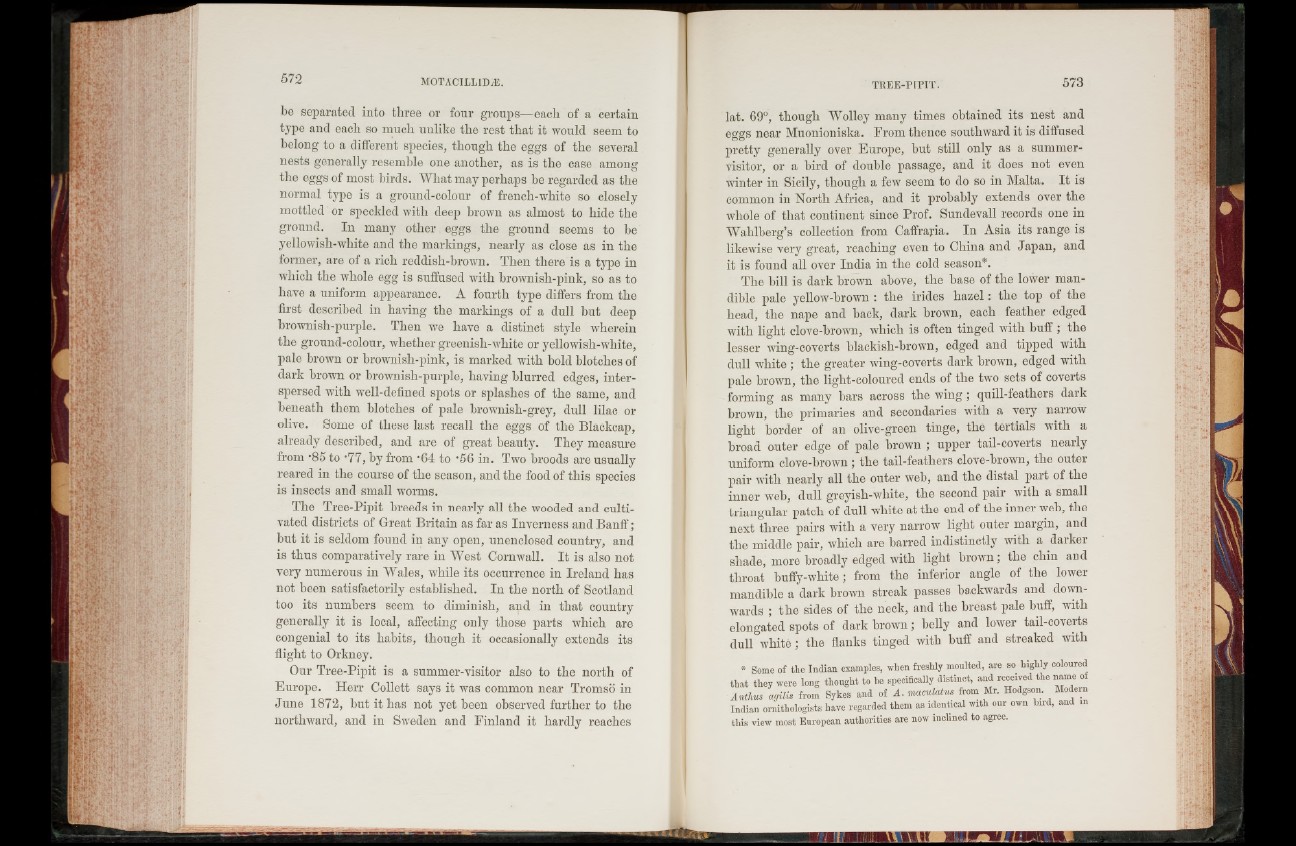
be separated into three or four groups—each of a certain
type and each so much unlike the rest that it would seem to
belong to a different species, though the eggs of the several
nests generally resemble one another, as is the case among
the eggs of most birds. What may perhaps be regarded as the
normal type is a ground-colour of french-white so closely
mottled or speckled with deep brown as almost to hide the
ground. In many other eggs the ground seems to be
yellowish-white and the markings, nearly as close as in the
former, are of a rich reddish-brown. Then there is a type in
which the whole egg is suffused with brownisli-pink, so as to
have a uniform appearance. A fourth type differs from the
first described in having the markings of a dull but deep
brownish-purple. Then we have a distinct style wherein
the ground-colour, whether greenish-white or yellowish-white,
pale brown or brownish-pink, is marked with bold blotches of
dark brown or brownish-purple, having blurred edges, interspersed
with well-defined spots or splashes of the same, and
beneath them blotches of pale brownish-grey, dull lilac or
olive. Some of these last recall the eggs of the Blackcap,
already described, and are of great beauty. They measure
from •85 to -77, by from '64 to ’56 in. Two broods are usually
reared in the course of the season, and the food of this species
is insects and small worms.
The Tree-Pipit breeds in nearly all the wooded and cultivated
districts of Great Britain as far as Inverness and Banff;
but it is seldom found in any open, unenclosed country, and
is thus comparatively rare in West Cornwall. I t is also not
very numerous in Wales, while its occurrence in Ireland has
not been satisfactorily established. In the north of Scotland
too its numbers seem to diminish, and in that country
generally it is local, affecting only those parts which are
congenial to its habits, though it occasionally extends its
flight to Orkney.
Our Tree-Pipit is a summer-visitor also to the north of
Europe. Herr Collett says it was common near Tromso in
June 1872, but it has not yet been observed further to the
northward, and in Sweden and Finland it hardly reaches
lat. 69°, though Wolley many times obtained its nest and
eggs near Muonioniska. From thence southward it is diffused
pretty generally over Europe, but still only as a summer-
visitor, or a bird of double passage, and it does not even
winter in Sicily, though a few seem to do so in Malta. I t is
common in North Africa, and it probably extends over the
whole of that continent since Prof. Sundevall records one in
Wahlberg’s collection from Caffrajna. In Asia its range is
likewise very great, reaching even to China and Japan, and
it is found all over India in the cold season*.
The bill is dark brown above, the base of the lower mandible
pale yellow-brown : the irides h a z e l: the top of the
head, the nape and back, dark brown, each feather edged
with light clove-brown, which is often tinged with b u ff; the
lesser wing-coverts blackish-brown, edged and tipped with
dull white ; the greater wing-coverts dark brown, edged with
pale brown, the light-coloured ends of the two sets of coverts
forming as many bars across the wing; quill-featliers dark
brown, the primaries and secondaries with a very narrow
light border of an olive-green tinge, the tertials with a
broad outer edge of pale brown ; upper tail-coverts nearly
uniform clove-brown ; the tail-feathers clove-brown, the outer
pair with nearly all the outer web, and the distal pait of the
inner web, dull greyisli-white, the second pair with a small
triangular patch of dull white at the end of the inner web, the
next three pairs with a very narrow light outer margin, and
the middle pair, which are barred indistinctly with a darker
shade, more broadly edged with light brown; the chin and
throat huffy-white; from the inferior angle of the lower
mandible a dark brown streak passes backwards and downwards
; the sides of the neck, and the breast pale buff, with
elongated spots of dark brown; belly and lower tail-coverts
dull white ; the flanks tinged with buff and streaked with
* Some of the Indian examples, when freshly moulted, are so highly coloured
that they were long thought to he specifically distinct, and received the name of
Anthus agilis from Sykes and of A. macuMus from Mr. Hodgson. Modem
Indian ornithologists have regarded them as identical with our own bird, and m